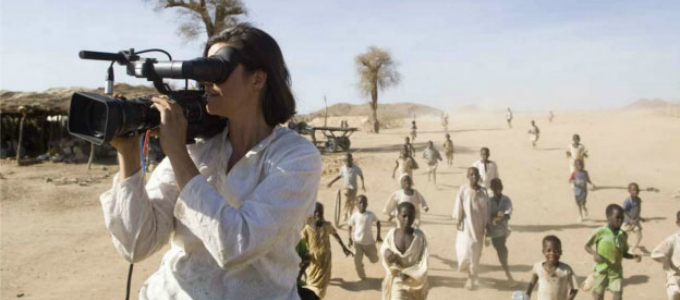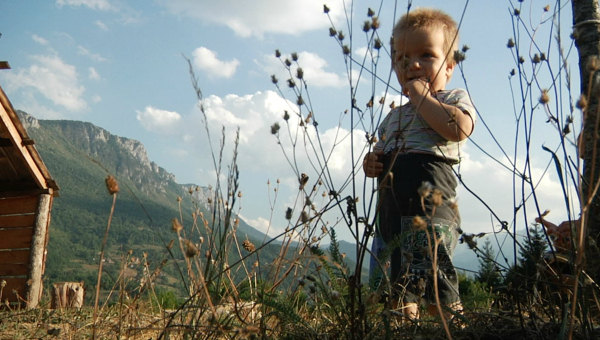 Kirsten Johnson humorously pulls out tufts of grass from in front of the camera, through a frustrating haze and vegetation that requires “natural editing”.
Kirsten Johnson humorously pulls out tufts of grass from in front of the camera, through a frustrating haze and vegetation that requires “natural editing”.
In this unique memoir, Johnson has produced a startling collage of her work, entwined with beautifully placed personal touches. With an impressive back catalogue including FAHRENHEIT 9/11 (2004) and DERRIDA (2002) Johnson’s personal memoir is made up of other people’s stories, which offer an incredibly insightful look into the true reality of documentary filmmaking.
CAMERAPERSON could have easily become a jumbled mess of scrap footage but Johnson has gathered material in such a way that it is hard not to become invested in the individual stories, even during a mere 30 seconds of film. Stories are developed throughout: a Muslim family living in Foča, a Nigerian midwife and a wounded boy in Afghanistan all re-appear, giving the film a linearity. The collage also plays host to footage of her father and her two children as well as her mother, who slowly becomes less lucid as she succumbs to Alzheimer’s.
Several short montages throughout the film aid audience reflection and allow thinking time; one that stands out is a series of still shots (Wounded Knee, The World Trade Centre, Tahrir Square) a sequence that narrates the historical horrors of the human world. It addresses the morality of documentary filmmaking, and more so, how what is being documented promulgates humans as voyeurs of horror.
“Americans act like they’re being filmed”
CAMERAPERSON shows the art of the documentary and its uniqueness as a form of storytelling. There’s the push and pull between being an observer and being emotionally involved with individual stories which creates a fascinating and engaging truth behind each film. Johnson breaks away from the role of observer occasionally, reassuring a young girl at a family planning clinic, as a friend would do. The way the subjects interact with Johnson herself, shows the impact felt by individuals both in front of and behind the camera. A fundamental element in order to accurately portray the reality of each story, and why it shouldn’t surprise audiences that Johnson felt this was integral to her cinematic memoir alongside family footage.
As well as beautifully endearing and thought provoking sequences, CAMERAPERSON reveals an underlying theme of Western culture and the media. Instead of being mesmerized by the camera, or just too busy to realise it’s there, the American subjects remain un-fazed, comfortable and often more animated and feigning under the gaze of the lens. “Americans act like they’re being filmed”, Jacques Derrida paraphrases while crossing a busy Manhattan road, calling into question documentary realism and authenticity in the Western world. What real stories can be captured if the subjects themselves have evolved to adopt a demeanour that places them in front of a metaphorical camera all of the time?
What CAMERAPERSON leaves behind is not only a unique insight into documentary filmmaking from an angle minimally explored, but with it, a wider sense of knowing. Every story, including her own, lingers long after the lights go up in this thoughtful, well-constructed cinematic scrapbook.
httpvh://youtu.be/jx52F4iLTL8


I am sure that it is meant as an affectionate description, but a scrapbook is just a scrapbook, even if it is thoughtful, well constructed and cinematic, and it is not a term that naturally suggests, as the review does, doing justice to what the film is :
After all, any documentary, even when shot mainly anew, is a work of producing usable material and editing the footage, so – as suggested by the comment ‘CAMERAPERSON could have easily become a jumbled mess of scrap footage’ – there is no reason why that should have been the case. (Whereas one can see plenty of documentaries made by film-makers who are so close to the story that they cannot see that they have told it. As true, when using mainly archival material.)
As to yoking Derrida (2002) and Fahrenheit 9 / 11 (2004), they really have little in common, because Johnson is the cinematographer in the former, but just one of more than half-a-dozen additional camera operators for Michael Moore’s film (with Mike Desjarlais credited as ‘camera operator’) : Johnson includes footage for those films for other reasons, and they go into this self-portrait of ‘Cameraperson’, which shows all the ways in which she was worked with others (and with five credits as a director in her own right).